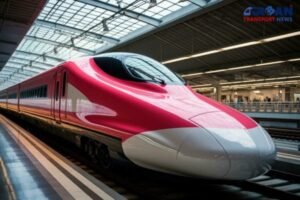
Why bullet trains in news?
- India is embarking on a groundbreaking journey to develop its own bullet trains network, with a focus on indigenous technology.
- This initiative promises to revolutionize travel experiences and propel the country into the league of nations with advanced transportation infrastructure.
A Vision for Faster, More Efficient Travel
- The indigenous bullet train project targets speeds exceeding 250 kilometers per hour (km/h), significantly surpassing the capabilities of existing trains on the Indian Railways network.
- This leap forward aligns with the global definition of high-speed trains, joining the ranks of the French TGV and the Japanese Shinkansen.
Building on the Success of Vande Bharat
- The indigenous bullet trains draw inspiration from the successful Vande Bharat platform, a semi-high-speed train developed by the Integral Coach Factory (ICF) in Chennai.
- Currently, Vande Bharat trains operate at a maximum speed of 160 km/h, with the potential to reach 180 km/h.
- Notably, these trains boast an impressive acceleration rate, reaching 100 km/h from a standstill in just 52 seconds.
Indigenous Corridors to Showcase Domestic Prowess
- The new bullet train initiative prioritizes the use of Indian technology and domestic manufacturing.
- These “made-in-India” trains are designated to run along the recently announced north, south, and east corridors.
- This approach fosters self-reliance and strengthens India’s position in the high-speed rail domain.
Complementing the Western Corridor: A Blend of Expertise
- India’s foray into bullet trains isn’t entirely new. The western corridor, connecting Mumbai and Ahmedabad, is under construction and leverages advanced Japanese technology.
- The Japan International Cooperation Agency (JICA) is providing financial aid for this project, which utilizes the Shinkansen E5 series bullet trains with a top speed of 320 km/h.
- This collaboration demonstrates India’s commitment to incorporating global expertise while fostering domestic innovation.
Rapid Progress on the Mumbai-Ahmedabad High-Speed Rail Project
- The National High-Speed Rail Corporation Limited (NHSRCL), the body entrusted with executing India’s first bullet train project, has made significant strides.
- They recently announced the completion of 300 kilometers of pier work, and crucially, the land acquisition process for the entire 508-kilometer stretch was finalized in January 2024.
- These milestones pave the way for the swift completion of this ambitious project.
The Vande Bharat Express: A Glimpse into the Future
- The Vande Bharat Express serves as a testament to India’s growing prowess in developing advanced trains.
- This indigenous electric multiple unit (EMU) train offers a plethora of modern amenities, including air-conditioning, onboard Wi-Fi, a GPS-based passenger information system, automatic doors, and bio-vacuum toilets.
- The train’s aerodynamic design, coupled with a driver-guard communication system, prioritizes safety and efficiency.
- With plans to manufacture 400 new Vande Bharat trains in the coming years, this initiative is poised to transform travel experiences across India.
About NHSRCL
- The National High-Speed Rail Corporation Limited (NHSRCL) stands at the forefront of India’s high-speed rail revolution.
- Established in 2016, this government-owned organization shoulders the critical responsibility of developing, constructing, and operating India’s first bullet train project – the Mumbai-Ahmedabad High-Speed Rail Corridor.
Conclusion
- India’s indigenous bullet train project signifies a paradigm shift in the country’s transportation landscape.
- By prioritizing domestic manufacturing and technological advancements, this initiative promises to reduce travel times, enhance connectivity, and propel India’s economic growth.
- The project serves as a beacon of the nation’s aspirations to become a global leader in high-speed rail technology.
- As the project progresses, India is set to break new ground and redefine the future of travel.
People also ask
Q1: What is India’s indigenous bullet train project?
Ans: India is developing its own high-speed rail network, with a focus on designing and manufacturing bullet trains domestically. These trains will exceed speeds of 250 kilometers per hour (km/h), significantly faster than existing trains in India.
Q2: How will the indigenous trains differ from the ones planned for the Mumbai-Ahmedabad corridor?
Ans: The Mumbai-Ahmedabad corridor utilizes Japanese Shinkansen bullet train technology. The indigenous trains will be designed and manufactured in India, showcasing domestic capabilities.
Q3: What are the planned routes for the indigenous bullet trains?
Ans: The specific routes haven’t been finalized, but newly announced north, south, and east corridors are designated for these trains.
Q4: What is the current status of the project?
Ans: The project is in its initial stages. The Vande Bharat platform, a semi-high-speed train, serves as a foundation for this initiative. The Integral Coach Factory (ICF) is leading the design process.
Thank you for your sharing. I am worried that I lack creative ideas. It is your article that makes me full of hope. Thank you. But, I have a question, can you help me?
I don’t think the title of your article matches the content lol. Just kidding, mainly because I had some doubts after reading the article.
Thank you for your sharing. I am worried that I lack creative ideas. It is your article that makes me full of hope. Thank you. But, I have a question, can you help me?